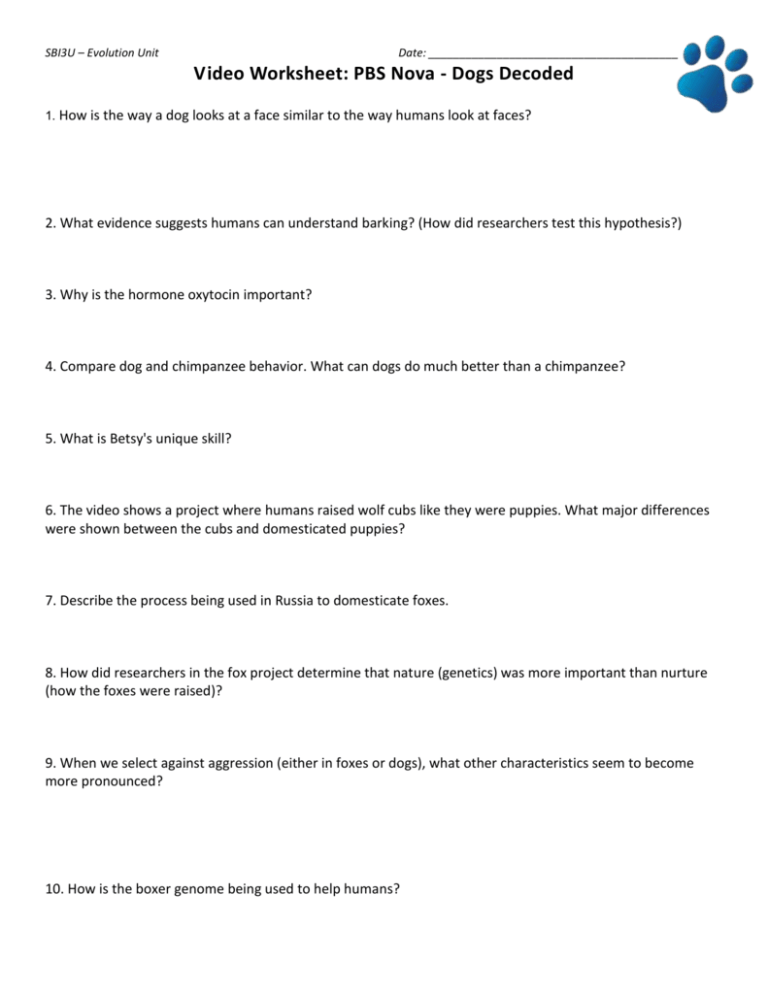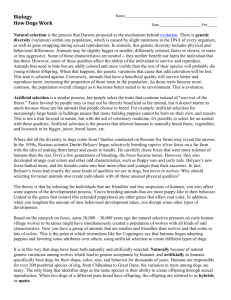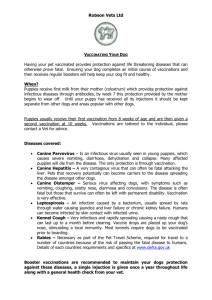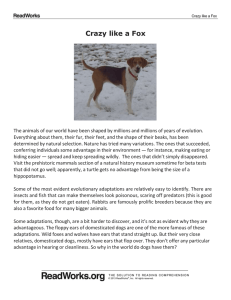Dogs Decoded: Evolution Worksheet - SBI3U Biology
advertisement

SBI3U – Evolution Unit Date: ________________________________________ Video Worksheet: PBS Nova - Dogs Decoded 1. How is the way a dog looks at a face similar to the way humans look at faces? 2. What evidence suggests humans can understand barking? (How did researchers test this hypothesis?) 3. Why is the hormone oxytocin important? 4. Compare dog and chimpanzee behavior. What can dogs do much better than a chimpanzee? 5. What is Betsy's unique skill? 6. The video shows a project where humans raised wolf cubs like they were puppies. What major differences were shown between the cubs and domesticated puppies? 7. Describe the process being used in Russia to domesticate foxes. 8. How did researchers in the fox project determine that nature (genetics) was more important than nurture (how the foxes were raised)? 9. When we select against aggression (either in foxes or dogs), what other characteristics seem to become more pronounced? 10. How is the boxer genome being used to help humans? SBI3U – Evolution Unit Date: ________________________________________ Video Worksheet: PBS Nova - Dogs Decoded ANSWER KEY 1. How is the way a dog looks at a face similar to the way humans look at faces? They look left then right at human face just the way human do suggesting dogs might be able to read human emotions 2. What evidence suggests humans can understand barking? (How did researchers test this hypothesis?) Video recording different dog barking in different situation were given to people to decipher the meaning of those barks. All test subject shown in the videos were able to guess the correct scenarios of the dogs that were recorded. 3. Why is the hormone oxytocin important? It creates and reinforce a bond between newborn babies and their mothers. Oxytocin plays similar role between dogs and their owners. Oxytocin spikes are observed in from blood samples withdrawn from both dogs and their owners after contact. 4. Compare dog and chimpanzee behavior. What can dogs do much better than a chimpanzee? Dogs and even puppies can understand human gestures eg pointing and the direction of our gaze; something that our cousin chimp. cannot do. 5. What is Betsy's unique skill? Betsy is able to distinguish objects by names with an impressive vocab. of 340 words. She can accurately choose and pick up objects based on visual cues (3D version of the objects as well as pictures) 6. The video shows a project where humans raised wolf cubs like they were puppies. What major differences were shown between the cubs and domesticated puppies? Puppies were pretty much curious and interested in the owner's activities while wolf cubs are indifferent. Wolf cubs are also more aggressive, possessive than dogs and don't respond to pointing and maintain eye contacts the way dogs do. 7. Describe the process being used in Russia to domesticate foxes. It is a 50-years domesticated experiment of silver foxes (a relative to wolves which are dogs' ancestor) in which only the tamest foxes are allowed to breed (i.e selective breeding). The aggressive behaviour displayed by the wild foxes at the beginning of the experiment began to disappear within 3 generations of selective breeding. 8. How did researchers in the fox project determine that nature (genetics) was more important than nurture (how the foxes were raised)? Aggressive cubs were given to tame mothers. Embryos from aggressive mothers were implanted in tamed mother and vice versa. Both experiments yielded the same result: cubs from aggressive breeds stay aggressive regardless of the environment they were raised in. This confirms the genetics root of aggressiveness observed in foxes. (Tamer foxes produces less adrenaline and thus are not as aggressive as the wild foxes which produce more adrenaline) 9. When we select against aggression (either in foxes or dogs), what other characteristics seem to become more pronounced? the light color pattern on silver foxes also changes, limbs and tails become shorter; tails become more curly, adults retains floppy ears for longer period of time and infantile features 10. How is the boxer genome being used to help humans? Boxer genome works as a model that helps accelerate research in understanding the genetics of human diseases and in finding the genes responsible for similar diseases in human. Boxers suffer a fatal heart disease called cardiomyopathy. The genomes of sick and healthy boxers are compared and mutations that might have caused the diseases are narrowed down to chromosome #17 in boxers. We can use this knowledge and look for the genes responsible for similar diseases in human.







